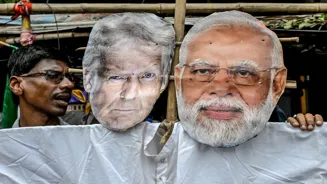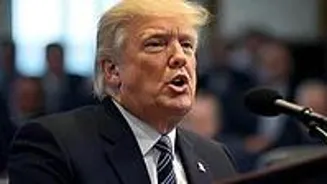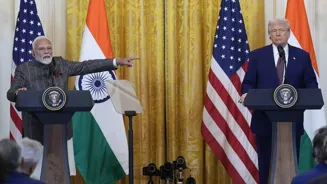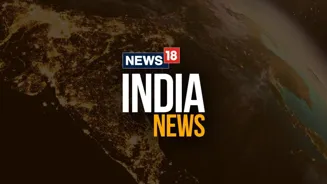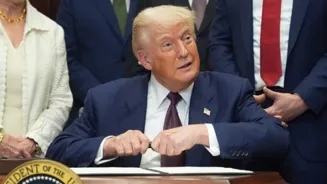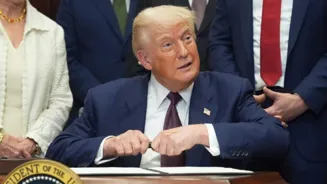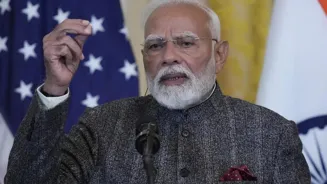What is the story about?
Donald Trump has intensified his trade war with India. On Wednesday (August 6), the US president announced sweeping and substantial tariffs on India, which is also one of America’s foremost trading partners.
In addition to a 25 per cent tariff, which comes into effect today (August 7), he has levied another 25 per cent tariffs, which will come into effect on August 27, as punishment for its oil trade with Russia. This takes the total tariff on Indian goods to 50 per cent, making it the highest tariffs in the world, alongside fellow Brics member Brazil.
Responding to the Trump’s latest move, India said it was “unfair, unjustified and unreasonable”. The Ministry of External Affairs (MEA) said that Washington “targeted” its
oil imports from Russia and that it will “take all actions” necessary to protect national interests.
But as many wake up to this news and try to wrap their minds around it, we examine what would be the impact of such a move on India. What would it mean for the country’s economy and trade?
After making ultimatums to India on its purchase of Russian oil, Trump finally announced an additional 25 per cent tariff on India on Wednesday, marking an escalation of his trade
battle with New Delhi.
He signed an emergency executive order titled “Addressing Threats to the US by the Russian Federation”, in which he invoked his constitutional powers to claim that Russia and Russian products posed an “unusual and extraordinary threat to the national security and foreign policy of the United States”. He singled out India for its continued imports of Russian oil directly or indirectly.
This 25 per cent penalty on India for buying Russian oil comes on top of the 25 per cent tariff he imposed on
India late last month. This effectively takes India’s cumulative tariff rate to a whopping 50 per cent.
Notably, the new, Russia-related tariffs will take effect in 21 days — August 27, while the other 25 per cent tariff comes into effect today (August 7).
Trump’s penalty on India is a follow-up to the US president’s earlier threats, saying India was helping Russia wage war in Ukraine. “India is not only buying massive amounts of Russian oil, they are then, for much of the oil purchased, selling it on the open market for big profits. They don’t
care how many people in Ukraine are being killed by the Russian war machine,” he wrote on social media.
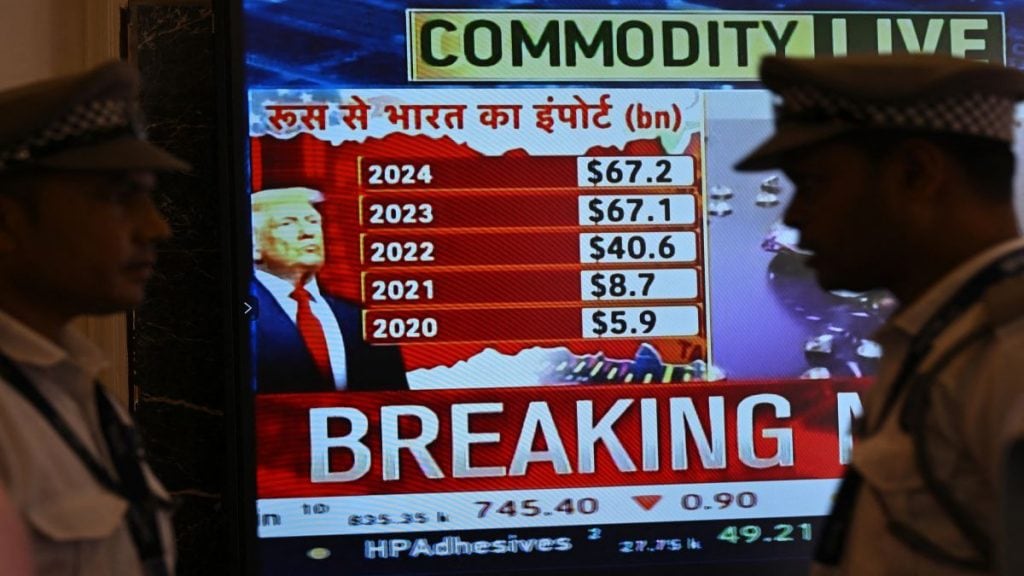
India responded to the tariffs, defending its purchase of Russian oil and stating that it would take all actions necessary to protect its national interests.
“We have already made clear our
position on these issues, including the fact that our imports are based on market factors and done with the overall objective of ensuring the energy security of 1.4 billion people of India,” said the MEA, adding, “It is therefore extremely unfortunate that the US should choose to impose additional tariffs on India for actions that several other countries are also taking in their own national interest. We reiterate that these actions are unfair, unjustified and unreasonable.”
Congress leaders Rahul
Gandhi and Shashi Tharoor also slammed Trump’s tariffs on India. Gandhi termed the 50 per cent hike an “economic blackmail”. “Trump’s 50 per cent tariff is economic blackmail — an attempt to bully India into an unfair trade deal. PM Modi better not let his weakness override the interests of the Indian people,” Gandhi said in a post on X.
Tharoor also called out the tariffs, saying it was a blow to India. “Uranium, Palladium, there are various things they (US) are importing from Russia. There is, unfortunately, a certain
double standard involved. They have given the Chinese a 90-day break, but the Chinese are importing far more Russian oil than we are. So clearly this has not been a particularly friendly gesture from a country we thought was well disposed towards us, an administration that we thought was well disposed.”
“We will have to learn our lessons from this experience. I think there is certainly a likelihood that there will be some pressure within India now to impose comparable reciprocal tariffs on American exports to India. So I think we’re
going to have to really start looking at other trading partners much more in these circumstances,” Tharoor added.
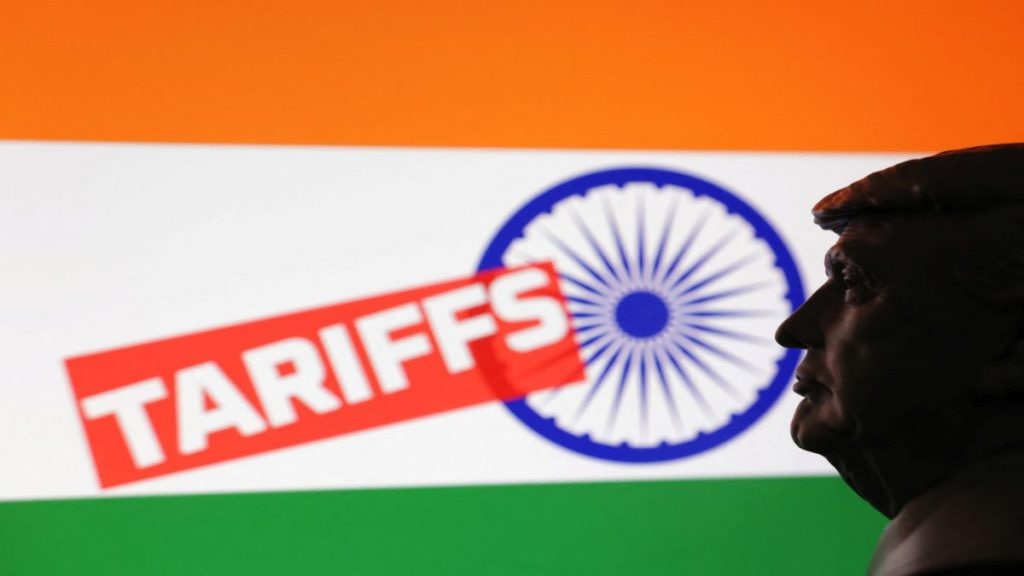
The move by the US president has sent shockwaves through India — as New Delhi considered America as a strategic ally. Many also fear the true impact that such high tariffs will have for India.
Analysts fear that Trump’s 50 per cent tariff could cause a multi-billion dollar hit to the Indian economy, as the additional tariffs obviously means a much higher cost for Indian exports in products like auto parts, textile, and electronics. Many noted that steel, chemical and pharma industries will be affected and may face a huge setback. As per UBS, $8 billion worth of exports are most vulnerable, including gems and jewellery, apparel, textiles, and chemicals.
Experts pointed out that the tariff
hike will impact nearly 60 per cent of India’s $91 billion exports to the US — amounting to around $63.5 billion in vulnerable trade.
Indian exporters also fear that the 50 per cent tariff would reduce their products competitiveness. The tariff on India is much higher than other Asian nations such as Vietnam, Bangladesh, Pakistan and the Philippines all of whom have been assigned lower duty rates of 19–20 per cent.
As India’s tariff is now 50 per cent, it would eat into India’s competitiveness in sectors such as
apparel, home furnishing and other labour-intensive goods. Rahul Ahluwalia of the Foundation for Economic Development think-tank, explained toBBC, “A 25 per cent tariff plus additional penalties will leave India worse off relative to other Asian economies like Vietnam and China, the main countries we are competing against for investment and industrialisation.”
Some trade and economic experts said that if sustained these tariffs could even impact India’s Gross Domestic Product (GDP). Sakshi Gupta, principal economist
at HDFC Bank, was quoted as tellingReuters: “While Trump’s order gives another 21 days for a deal to breakthrough, in case it does not we will have to significantly lower FY26 GDP growth forecast to below six per cent, baking in a 40-50 bps hit. This would be double our earlier estimates (of GDP hit from higher tariffs).”
Echoing similar sentiments, Gaura Sen Gupta, economist at IDFC First Bank, told Reuters, “Post this order bilateral tariffs will rise to 50 per cent, which would be the highest applied
from August onwards. This definitely increases the downside risk to the 2025-26 GDP estimate. For now, if the tariffs persist till March 2026, total downside risk is estimated at 0.3 per cent to 0.4 per cent.”
Apart from this, many Indian MSME exporters have expressed concern over layoffs. Israr Ahmed, former vice president of Federation of Indian Export Organisations, in a Moneycontrolreport warned of massive job losses, particularly in sectors like apparel, textiles, marine products, and footwear, calling them
“employment-heavy and margin-thin.”
But its not just Indians who are worried about the impact of Trump’s tariffs. Some Americans fear the move could backfire on them and US customers would eventually have to pay more for Indian products
And it seems that Trump isn’t done yet with India; he’s warned of more secondary sanctionson India over its continued purchase of oil from Russia. “It’s only been eight hours. So, let’s see what happens,” Trump told reporters when asked why India was being singled out while
countries like China also continue to buy Russian oil. “You’re going to see a lot more. You’re going to see so many secondary sanctions.”
Indian officials remain hopeful of a resolution in the form of a trade deal. A government source told News18 that the 21-day window is an indicator that Trump is still open to talks.
In the meantime, India is exploring domestic relief measures for exporters, including interest subsidies and credit guarantees. But economists warn of the impact of these tariffs, noting that GDP growth would
fall below six per cent this year.
With inputs from agencies
In addition to a 25 per cent tariff, which comes into effect today (August 7), he has levied another 25 per cent tariffs, which will come into effect on August 27, as punishment for its oil trade with Russia. This takes the total tariff on Indian goods to 50 per cent, making it the highest tariffs in the world, alongside fellow Brics member Brazil.
Responding to the Trump’s latest move, India said it was “unfair, unjustified and unreasonable”. The Ministry of External Affairs (MEA) said that Washington “targeted” its
But as many wake up to this news and try to wrap their minds around it, we examine what would be the impact of such a move on India. What would it mean for the country’s economy and trade?
What did Trump announce on India tariffs?
After making ultimatums to India on its purchase of Russian oil, Trump finally announced an additional 25 per cent tariff on India on Wednesday, marking an escalation of his trade
He signed an emergency executive order titled “Addressing Threats to the US by the Russian Federation”, in which he invoked his constitutional powers to claim that Russia and Russian products posed an “unusual and extraordinary threat to the national security and foreign policy of the United States”. He singled out India for its continued imports of Russian oil directly or indirectly.
This 25 per cent penalty on India for buying Russian oil comes on top of the 25 per cent tariff he imposed on
Notably, the new, Russia-related tariffs will take effect in 21 days — August 27, while the other 25 per cent tariff comes into effect today (August 7).
Trump’s penalty on India is a follow-up to the US president’s earlier threats, saying India was helping Russia wage war in Ukraine. “India is not only buying massive amounts of Russian oil, they are then, for much of the oil purchased, selling it on the open market for big profits. They don’t

Trump's Wednesday tariff of 25 per cent is a punishment for India's oil trade with Russia, that the US president claims is funding the war against Ukraine. File image/AFP
How has India reacted to the tariffs?
India responded to the tariffs, defending its purchase of Russian oil and stating that it would take all actions necessary to protect its national interests.
“We have already made clear our
Congress leaders Rahul
Tharoor also called out the tariffs, saying it was a blow to India. “Uranium, Palladium, there are various things they (US) are importing from Russia. There is, unfortunately, a certain
“We will have to learn our lessons from this experience. I think there is certainly a likelihood that there will be some pressure within India now to impose comparable reciprocal tariffs on American exports to India. So I think we’re

US President Donald Trump's decision to impose 50% tariffs on goods imported from India could hit the country's growth prospects. File image/Reuters
What do Trump’s tariffs mean for India?
The move by the US president has sent shockwaves through India — as New Delhi considered America as a strategic ally. Many also fear the true impact that such high tariffs will have for India.
Experts pointed out that the tariff
Indian exporters also fear that the 50 per cent tariff would reduce their products competitiveness. The tariff on India is much higher than other Asian nations such as Vietnam, Bangladesh, Pakistan and the Philippines all of whom have been assigned lower duty rates of 19–20 per cent.
As India’s tariff is now 50 per cent, it would eat into India’s competitiveness in sectors such as
Some trade and economic experts said that if sustained these tariffs could even impact India’s Gross Domestic Product (GDP). Sakshi Gupta, principal economist
Echoing similar sentiments, Gaura Sen Gupta, economist at IDFC First Bank, told Reuters, “Post this order bilateral tariffs will rise to 50 per cent, which would be the highest applied
Apart from this, many Indian MSME exporters have expressed concern over layoffs. Israr Ahmed, former vice president of Federation of Indian Export Organisations, in a Moneycontrolreport warned of massive job losses, particularly in sectors like apparel, textiles, marine products, and footwear, calling them
But its not just Indians who are worried about the impact of Trump’s tariffs. Some Americans fear the move could backfire on them and US customers would eventually have to pay more for Indian products
What comes next?
And it seems that Trump isn’t done yet with India; he’s warned of more secondary sanctionson India over its continued purchase of oil from Russia. “It’s only been eight hours. So, let’s see what happens,” Trump told reporters when asked why India was being singled out while
Indian officials remain hopeful of a resolution in the form of a trade deal. A government source told News18 that the 21-day window is an indicator that Trump is still open to talks.
In the meantime, India is exploring domestic relief measures for exporters, including interest subsidies and credit guarantees. But economists warn of the impact of these tariffs, noting that GDP growth would
With inputs from agencies
Do you find this article useful?
